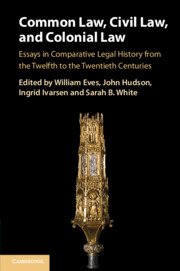193 results
The contested jurisdiction of Social Policy in UK universities since 1972
-
- Journal:
- Journal of Social Policy / Volume 51 / Issue 3 / July 2022
- Published online by Cambridge University Press:
- 13 April 2022, pp. 487-503
- Print publication:
- July 2022
-
- Article
-
- You have access
- Open access
- HTML
- Export citation
14 - Glanvill:
- from Part II - Historians, Lawyers and Exegetes: Writing Lives and Identities
-
-
- Book:
- Lives, Identities and Histories in the Central Middle Ages
- Published online:
- 24 September 2021
- Print publication:
- 07 October 2021, pp 264-281
-
- Chapter
- Export citation
Introduction: Situating, Researching, and Writing Comparative Legal History
-
-
- Book:
- Common Law, Civil Law, and Colonial Law
- Published online:
- 01 April 2021
- Print publication:
- 15 April 2021, pp 1-24
-
- Chapter
-
- You have access
- Open access
- HTML
- Export citation
Contents
-
- Book:
- Common Law, Civil Law, and Colonial Law
- Published online:
- 01 April 2021
- Print publication:
- 15 April 2021, pp v-vi
-
- Chapter
-
- You have access
- Open access
- HTML
- Export citation
Index
-
- Book:
- Common Law, Civil Law, and Colonial Law
- Published online:
- 01 April 2021
- Print publication:
- 15 April 2021, pp 323-338
-
- Chapter
-
- You have access
- Open access
- HTML
- Export citation
Contributors
-
- Book:
- Common Law, Civil Law, and Colonial Law
- Published online:
- 01 April 2021
- Print publication:
- 15 April 2021, pp vii-viii
-
- Chapter
-
- You have access
- Open access
- HTML
- Export citation
Acknowledgments
-
- Book:
- Common Law, Civil Law, and Colonial Law
- Published online:
- 01 April 2021
- Print publication:
- 15 April 2021, pp ix-x
-
- Chapter
-
- You have access
- Open access
- HTML
- Export citation
Copyright page
-
- Book:
- Common Law, Civil Law, and Colonial Law
- Published online:
- 01 April 2021
- Print publication:
- 15 April 2021, pp iv-iv
-
- Chapter
-
- You have access
- Open access
- HTML
- Export citation

Common Law, Civil Law, and Colonial Law
- Essays in Comparative Legal History from the Twelfth to the Twentieth Centuries
-
- Published online:
- 01 April 2021
- Print publication:
- 15 April 2021
-
- Book
-
- You have access
- Open access
- Export citation
Exploring seed longevity of UK native trees: implications for ex situ conservation
-
- Journal:
- Seed Science Research / Volume 30 / Issue 2 / June 2020
- Published online by Cambridge University Press:
- 21 July 2020, pp. 101-111
-
- Article
- Export citation
The evolving Japanese: the dual structure hypothesis at 30
-
- Journal:
- Evolutionary Human Sciences / Volume 2 / 2020
- Published online by Cambridge University Press:
- 24 February 2020, e6
-
- Article
-
- You have access
- Open access
- HTML
- Export citation
Equivalency of the diagnostic accuracy of the PHQ-8 and PHQ-9: a systematic review and individual participant data meta-analysis – ERRATUM
-
- Journal:
- Psychological Medicine / Volume 50 / Issue 16 / December 2020
- Published online by Cambridge University Press:
- 19 August 2019, p. 2816
-
- Article
-
- You have access
- HTML
- Export citation
Equivalency of the diagnostic accuracy of the PHQ-8 and PHQ-9: a systematic review and individual participant data meta-analysis
-
- Journal:
- Psychological Medicine / Volume 50 / Issue 8 / June 2020
- Published online by Cambridge University Press:
- 12 July 2019, pp. 1368-1380
-
- Article
- Export citation
5 - Reading Terminology in the Sources for the Early Common Law: Seisin, Simple and Not So Simple
- from Part II - Courts and Records of Litigation
-
-
- Book:
- English Legal History and its Sources
- Published online:
- 12 April 2019
- Print publication:
- 02 May 2019, pp 79-99
-
- Chapter
- Export citation
Probability of major depression diagnostic classification using semi-structured versus fully structured diagnostic interviews
-
- Journal:
- The British Journal of Psychiatry / Volume 212 / Issue 6 / June 2018
- Published online by Cambridge University Press:
- 02 May 2018, pp. 377-385
- Print publication:
- June 2018
-
- Article
-
- You have access
- HTML
- Export citation
4 - The Place of Henry I in English Legal History
-
-
- Book:
- The Haskins Society Journal
- Published by:
- Boydell & Brewer
- Published online:
- 23 August 2019
- Print publication:
- 02 October 2017, pp 63-82
-
- Chapter
- Export citation
Contents
-
- Book:
- Social Policy in an Era of Competition
- Published by:
- Bristol University Press
- Published online:
- 05 April 2022
- Print publication:
- 30 June 2017, pp iii-iv
-
- Chapter
- Export citation
twelve - Conclusion: social policy in an era of competition
-
-
- Book:
- Social Policy in an Era of Competition
- Published by:
- Bristol University Press
- Published online:
- 05 April 2022
- Print publication:
- 30 June 2017, pp 203-212
-
- Chapter
- Export citation
References
-
- Book:
- Social Policy in an Era of Competition
- Published by:
- Bristol University Press
- Published online:
- 05 April 2022
- Print publication:
- 30 June 2017, pp 213-250
-
- Chapter
- Export citation
Frontmatter
-
- Book:
- Social Policy in an Era of Competition
- Published by:
- Bristol University Press
- Published online:
- 05 April 2022
- Print publication:
- 30 June 2017, pp i-ii
-
- Chapter
- Export citation



